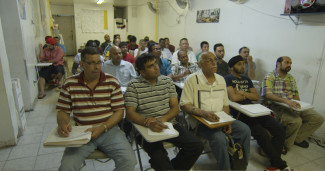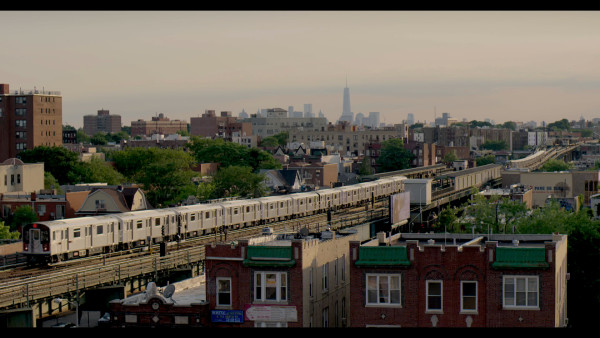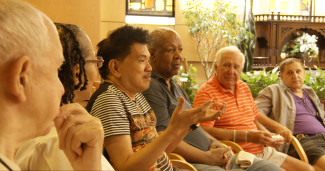REVIEW: ‘In Jackson Heights’ doc details life in Queens, NY

In Frederick Wiseman’s new documentary, In Jackson Heights, the Queens neighborhood that’s bordered by Astoria, Elmhurst and Woodside comes to life in front of the audience member’s eyes. Charting the many interconnected stories in the multicultural community, the film serves as a document of culture, showcasing the triumphs and struggles of families trying to thrive in a crowded landscape. From newly arrived immigrants to students in a taxi-driving school to business owners to soccer fans from Colombia to members of the LGBT community to Council Member Daniel Dromm, the subjects of the documentary are varied and unique, although the commonality is that most of them profess a love for this unique neighborhood across the East River from Manhattan.
The three-hour film, which is currently playing New York City’s Film Forum, has no voiceover or soundtrack, other than the songs and dialogue that come from the sidewalks, places of business and parks spread throughout the community. Characters come and go, with no beginning or end to their storyline. Wiseman seems more interested in weaving an intricate fabric and letting the viewer see the final patchwork product. It’s not about any individual person or movement; it’s about the totality of the neighborhood, the welcoming arms and cultural identities.

Several themes emerge from this series of city blocks, many of them shrouded by the shadows of the elevated 7 subway train. Discrimination against the gay and transgender community is discussed. Wiseman films not only a protest at a local business but also community gatherings where issues of safety, identity and society are discussed in an open format.
Newly arrived immigrants come together to hear testimonies of the hard journey they endured on their way to the United States. One woman’s account of her family’s turmoil crossing the border is quite captivating and holds one’s interest. There’s no need to contextualize the story; everyone seems to respect her telling of that reality. Other conversations focus on services and identification cards for the assembled families.
Another scene depicts prospective taxi drivers. An energetic teacher describes the bridges, tunnels, tolls and directions in a dynamic manner, making constant references to the cultures and differences in language of the applicants sitting before him.

A humorous scene occurs in Dromm’s office. Two assistants answer the phone with a saintly patience for the numerous complaints that emerge. They explain the jurisdictional differences among the city, state and federal governments to the angered callers. Most conversations end with a simple question: Do you have a concrete complaint?
After Colombia wins a match in the World Cup (it appears Wiseman filmed most of his action in the summer of 2014), soccer fans take to the sidewalks, waving their flags and chanting for their country’s team. The police stand by, sometimes arresting those revelers who get out of hand. Another quick scene shows a soccer jersey being bought for a little dog. Yet another scene has a group of older men sitting on the sidewalk watching a big-screen television in the window of a store. The channel is turned to a soccer match.
The retired community is depicted through a series of conversations that are quite revealing. One woman has no family and hardly any friends. She seems disconnected from the world and the younger generation. A Jewish congregation remembers those who lost their lives during the Holocaust. Another group of knitters and crocheters share a conversation about gardening in the community and their thoughts on cemeteries.
The conversations and scenes almost never stop coming in the three-hour documentary. One nighttime sequence takes place in a bar setting where the lights are turned low, the lasers are turned high and the beat is thumping. Another scene showcases the Queens Pride Parade and the words of Mayor Bill de Blasio and Dromm. Another group talks about discrimination in the neighborhood against the LGBT community and their thoughts on inclusion. One of the saddest episodes involves a storeowner facing the reality of losing his lease and watching the neighborhood he’s contributed so much to over the years slip away with higher rents and commercialized franchises.
There’s even a focus on the many signs, both neon and otherwise, that decorate the neighborhood. Announcements in several languages draw the eyes of passersby.
One uncomfortable sequence follows a few chickens as they are killed and prepared for sale. Vegetable and fruit stands sell the ripest selections. Street vendors cater to the walkers on the street. Activists, some religious and some cultural, offer their messages to anyone who stops and listens.
Wiseman, who also produced and edited the film, never comments on the discussions, never passes judgment, never offers a view of the world outside Jackson Heights. This makes In Jackson Heights a pure cinematic document, one of unfiltered access to one of the most interesting and dynamic places in the world.
If viewers look hard enough (it won’t take more than a few seconds), it will become obvious that many of these scenes provide talking points in the media, on the stage of presidential debates and in the hallowed rooms of city hall. From gentrification to immigration to gender identity to the retirement community, the issues that are present in Jackson Heights are the issues that Americans continually address and debate. Wiseman’s film puts a face on these issues. He strips away labels and political fighting, instead focusing on everyday reality — the coming and going and living of a community.
By John Soltes / Publisher / John@HollywoodSoapbox.com
- In Jackson Heights
- 2015
- Directed by Frederick Wiseman
- In English, Spanish and Arabic with English subtitles
- Running time: 190 minutes
- Rating:





